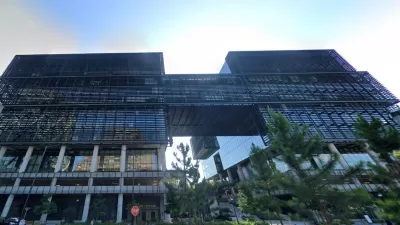Jeffrey Spivak reports on the federal government's pioneering efforts in net-zero building design and construction.
For those not familiar, "a net-zero building is one that, over the course of a year, produces as much energy as it needs through a combination of technological efficiencies and its own on-site energy generation, such as solar power," notes Spivak.
Although the amount of commercial buildings constructed to this high standard over the past decade can be counted with a few hands, "the federal government has taken net-zero architecture to a new level by incorporating it in larger commercial buildings," writes Spivak.
Such buildings as NASA's Sustainability Base at the Ames Research Center complex near San Jose, California, and the Department of Energy's 220,000-square-foot Research Support Facility at the National Renewable Energy Laboratory campus in Colorado, are introducing pioneering design and technologies not yet found in the private sector.
As it did in leading the way in the adoption of LEED standards at the beginning of the last decade, "it's the federal government that's been the most aggressive in mandating net zero energy for its next generation of buildings," beginning in 2007, reports Spivak.
And the government has set targets for net-zero adoption across all commercial buildings as well. "[T]he Department of Energy's Net-Zero Energy Commercial Building Initiative aims to research and market emerging technologies for net-zero buildings, with a goal of converting half of all public and private commercial buildings to net-zero energy by 2040 and the entire stock of U.S. commercial buildings by 2050."
FULL STORY: Uncle Sam, the Energy Miser

Planetizen Federal Action Tracker
A weekly monitor of how Trump’s orders and actions are impacting planners and planning in America.

Maui's Vacation Rental Debate Turns Ugly
Verbal attacks, misinformation campaigns and fistfights plague a high-stakes debate to convert thousands of vacation rentals into long-term housing.

San Francisco Suspends Traffic Calming Amidst Record Deaths
Citing “a challenging fiscal landscape,” the city will cease the program on the heels of 42 traffic deaths, including 24 pedestrians.

Amtrak Rolls Out New Orleans to Alabama “Mardi Gras” Train
The new service will operate morning and evening departures between Mobile and New Orleans.

The Subversive Car-Free Guide to Trump's Great American Road Trip
Car-free ways to access Chicagoland’s best tourist attractions.

San Antonio and Austin are Fusing Into one Massive Megaregion
The region spanning the two central Texas cities is growing fast, posing challenges for local infrastructure and water supplies.
Urban Design for Planners 1: Software Tools
This six-course series explores essential urban design concepts using open source software and equips planners with the tools they need to participate fully in the urban design process.
Planning for Universal Design
Learn the tools for implementing Universal Design in planning regulations.
Heyer Gruel & Associates PA
JM Goldson LLC
Custer County Colorado
City of Camden Redevelopment Agency
City of Astoria
Transportation Research & Education Center (TREC) at Portland State University
Jefferson Parish Government
Camden Redevelopment Agency
City of Claremont





























